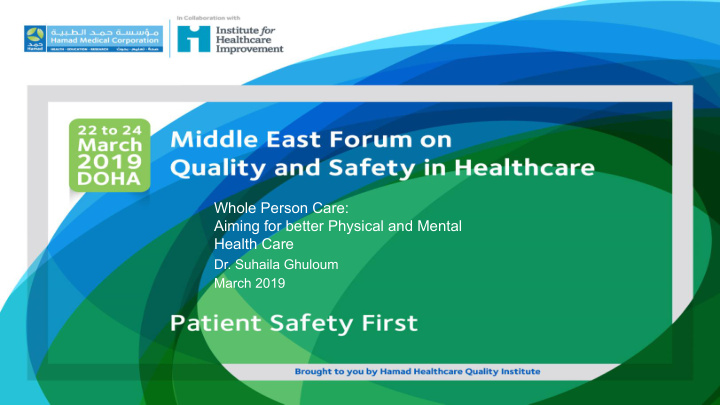



Whole Person Care: Aiming for better Physical and Mental Health Care Dr. Suhaila Ghuloum March 2019
Panel Members Dr. Suhaila Ghuloum, moderator Dr. Abdulla Bin Ammer, co-moderator Dr. Rajeev Kumar Dr. Awad Al-Qahtani Dr. Reem Alsulaiman Prof. Shahrad Taheri Dr. Samar Al-Emadi
As part of our extensive program and with CPD hours awarded based on actual time spent learning, credit hours are offered based on attendance per session, requiring delegates to attend a minimum of 80% of a session to qualify for the allocated CPD hours. • Less than 80% attendance per session = 0 CPD hours ME Forum 2019 Orientation • 80% or higher attendance per session = full allotted CPD hours Total CPD hours for the forum are awarded based on the sum of CPD hours earned from all individual sessions.
Conflict of Interest The speakers in this session have no conflict of interest or disclosure in relation to this presentation
Learning Objectives At the end of this session, participants will be able to: 1. Understand the concept of parity of esteem 2. Better appreciate the importance of integrated mental and physical healthcare provision 3. Discuss recommendations for achieving parity
• Equally valuing physical AND mental health • Equal access, equal spending • 46% of people with mental illness also have chronic physical illness • 30% of people with chronic physical illness have mental health conditions
Impact on Physical Health • Reduction in life expectancy • 7-10 years for depression • 10-15 schizophrenia • >15 substance misuse • Increase physical morbidity: CAD, obesity, hypertension, metabolic, smoking 4X MI, and death within 6/12 2XDM • non-compliance 3X
Impact on Mental Health • Depression doubled in DM, CAD, HT • 7X if two physical conditions • Tripled with CVA, ESRD • COPD à GAD, panic, depression • More admission, longer stay, higher relapse
Service Utilisation With MH symptoms Without MH symp. Overall utilization 78% 48% EMS access to ED 54% 26% “Emergency” 71% 40% Admission >> Length of stay 30% Preventable admissn. 3.6X > OPD visits >>
Gap • Prevalence of Mental Illness in Q is 1:5 • 25% Q seek service • Lower in non-Q • 3 of top 6 morbidities in Q are Mental illness • Excess mortality, highest among 30-39 age-groups. People in contact with specialist MHS have mortality rate 3.6X higher than gen. pop. • Burden of disease vs budget spent on MHS
Barriers • Lack of data • Stigma • Ethnic minorities • Deficient awareness/training • Missed diagnosis • Primary Care services
Panel Discussion
Parity • Equal access to most effective, safest, evidence-based Tx • Parity of Tx • Equal efforts to improve quality of care, allocation of resources proportionate with need • Equal status within education and practice • Research investment • Equally ‘high aspirations’ for service users • CL services 24hours access • CMHT, crisis resolution, 24hour access
Parity, cont…. • Patients with Schizophrenia: protocols, tools, shared care • Those with physical ill health to get regular mental health checks and vise versa • ‘street triage’ • Integrated chronic physical health and mental health care • RCPsych report on financial savings • Outcome measures, indicators, (e.g mortality) • Workforce training *** Leadership engagement/commitment
References 1. Moussavi et al 2007 2. NICE 2009 3. HSCIS 2013 4. Thornicroft 2011 5. RCPsych report: parity of esteem, from rhetoric to reality
Thank you.
Recommend
More recommend